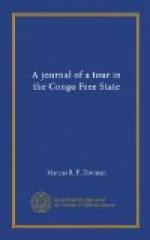We left Irebu on August 2nd and at once disturbed many crocodiles and hippos, which abound in this district. An unfortunate accident happened in the afternoon. One of the crew fell overboard and must have been drawn under the stern wheel and struck by a paddle, for he never re-appeared and no sign of the poor fellow could be found, although diligent search was made for a long time.
Just before sunset a canoe comes alongside and fastens to the ship, although it is travelling at full speed. It is indeed wonderful to see the way the natives manipulate these narrow dug-outs not two feet wide. In this one were three fishermen with some fish which looked like trout for sale. At once a great clamouring takes place among the native passengers and it soon becomes plain that the chief fisherman was a good man of business. Having taken an empty bottle for one fish and a piece of cloth for another, he refused more of those articles and demanded either salt or mitakos for his goods. In a short time however, he had disposed of his cargo and paddled contentedly away.
[Illustration: NATIVES OF THE UPPER CONGO.]
The natives are very vain and take much trouble over their personal appearance. As their clothes are very simple this is concentrated on their tatooage and on their hair dressing. From a hopeless looking tangle of black tow a very pretty erection is created by the barbers who are of both sexes. Often the hair has five or six separate partings and quills or feathers are inserted into the ridges in between. All the women here wear a simple piece of cloth as they do in the Lower Congo and sometimes a plain leather belt is worn round the waist. The arms and legs are bare and covered with plain bangles made of mitakos. The women wear no hat of any kind, but the men ape the Europeans and appear in old helmets or straw hats. Both sexes are very clean personally, and bathe frequently in the river, but never dry themselves afterwards. The men keep on their loin cloths, but if they wear also shirts or trousers, take these off, while the women bathe in a white linen loin cloth and everyone afterwards pulls on his other clothes without drying. Many natives rub a red powder into the skin made from cam-wood and thus acquire a copper colour, while others paint their faces with various stripes of red, yellow or white. On the Congo however, where the natives are becoming civilised, this custom seems to be dying out.




